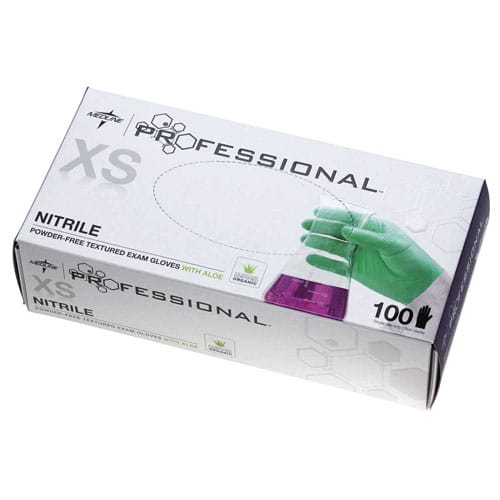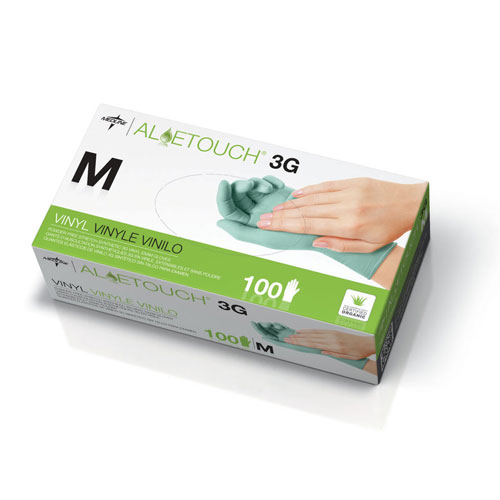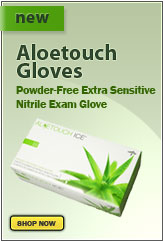Selecting Exam Gloves that Fit Your Needs
Published: May 27, 2010
Important factors to consider when selecting exam gloves for your facility
by Brian Palmer
 While exam gloves are the first line of defense against infection and contamination for healthcare workers, they can be a very "touchy" subject for facilities both literally and figuratively. Not only are they a major budget cost, but they can also be a very personal issue for clinicians when it comes to protection, function and skin health. Additionally, many people up to 20 percent of the population, by some estimates have developed an allergy to latex products.
While exam gloves are the first line of defense against infection and contamination for healthcare workers, they can be a very "touchy" subject for facilities both literally and figuratively. Not only are they a major budget cost, but they can also be a very personal issue for clinicians when it comes to protection, function and skin health. Additionally, many people up to 20 percent of the population, by some estimates have developed an allergy to latex products.
The good news is that there are new latex-free exam gloves available today that balance the needs on both sides of the table cost containment for purchasing and the safety, sensation and function that clinicians are looking for.
Newer technologies in nitrile and vinyl glove manufacturing have made them more affordable, functional and an increasingly popular substitute for latex gloves. In fact, at the end of 2008, non-latex accounted for more than 80 percent of exam gloves sold to hospitals in the United States.
New Technology and Affordability
Over the years, newer formulations and technology have allowed for the production of a nitrile glove that fits and feels more like latex (stretchier and with a better fit than previous nitrile exam gloves, which were much stiffer and thicker). For clinicians, this is a great latex-free option from a feel, fit and glove strength perspective. In addition to nitrile, many facilities throughout the United States are using vinyl exam gloves (made from PVC). While historically viewed as inadequate for use clinically, newer technologies in the past few years have also enabled the production of stronger and stretchier vinyl gloves.

New technology allows more cost-effective packaging of gloves.
The same technology that has made nitrile gloves fit and feel better has also made them more affordable. The newest nitrile gloves on the market cost less to produce because it takes less material to produce them. That also means that a larger quantity of gloves can be packaged into boxes that still fit standard glove-box holders. For example, Medline’s new SensiCare Ice and Aloetouch Ice gloves would have been traditionally packaged in a 100-count box, but advanced manufacturing technology allows Medline to package 200 in a box that will still fit in standard glove box holders. This translates over the long run to less cardboard packaging, less freight to ship the gloves and less facility space used for storage, which is great for the environment as well as the bottom line.
Right Fit, Proper Protection
There has been a recent trend sparked by the better fit, feel and cost-effectiveness of newer gloves for facilities to use one glove to cover every need. A one-size fits all approach might not be the right solution, however, as facilities need to balance cost effectiveness with providing clinicians with the right glove for their needs. For example, a high-stress environment like the emergency room typically requires a strong glove, because the stretch and strength of the glove are vital to ensuring that it is going to be an effective barrier to bloodborne pathogens. On the other hand, the cost of a very strong glove might be prohibitive for other areas within a facility that don’t put as much physical stress on gloves, such as dietary.
Many staff members "double glove," a practice in which two pairs of gloves are worn, one over the other. This creates a double layer of protection. If the outer glove starts to degrade or tear, the inner glove continues to offer protection until the gloves are removed and replaced. Those who double glove commonly wear a thin disposable glove (4 mil nitrile) under a heavier glove (8 mil nitrile). The outer glove is the primary protective barrier while the under glove offers dexterity and acts as a vapor barrier in the event of mechanical failure or the permeation of the outer glove. Alternately, healthcare workers can wear the heavier (and usually more expensive and durable) nitrile glove as the under glove and wear thinner disposable nitrile gloves over those, changing the thinner outer gloves frequently.
The information above highlights why all stakeholders in a facility need to be part of the glove selection process. Input from multiple sources helps ensure that appropriate vinyl and nitrile gloves are selected and also helps determine which gloves will be used in which departments. Some facilities choose to make only one type of glove available in specific departments while other departments might need access to both vinyl and nitrile gloves.
Healthy Skin
Clinician skin health should also be considered when selecting gloves, especially as it relates to hand hygiene compliance. Each year, an estimated 2-2.5 million patients in the United States develop nosocomial infections that result in 90,000 deaths and cost the healthcare system an estimated $4.5-$5.7 billion. Moreover, it is estimated that more than one-third of those infections could have been prevented through appropriate hand hygiene.
Hand hygiene (e.g., handwashing, hand antisepsis or surgical hand antisepsis) substantially reduces pathogens on the hands and is considered the single most critical measure for reducing infections. However, hand hygiene compliance by healthcare workers is poor, with an overall average compliance rate of 40 percent. According to studies, the number one reason healthcare workers do not follow their facility’s hand hygiene protocol is skin dryness and irritation.
The connection between hand hygiene compliance and skin irritation makes sense. Healthcare workers following proper infection control practices all day wind up doing some pretty harsh things to their hands. In fact, every time a healthcare worker takes off an exam glove, washes their hands and then puts on another pair of gloves, they become particularly susceptible to dry, rough and cracked skin. That discomfort makes it less likely that they will keep up with hand hygiene protocol.
As a result, the U.S. Centers for Disease Control and Prevention strongly recommend the regular use of products to help prevent skin irritation and moisturize hands affected by contact dermatitis. Introducing new strategies to minimize skin irritation may yield better compliance rates with hand hygiene and/or gloving practices. Therapeutic coated gloves such as Medline’s Aloetouch Ice, which have pure, freeze-dried aloe on the inside of the gloves, can reduce skin irritation.
The ramifications of chronic dry skin and dermatitis go beyond personal discomfort to the issues of personal health and safety. Cracks and fissures in the skin of dry hands increase occupational exposure of healthcare personnel to bloodborne viruses, such as hepatitis C and HIV. Skin moisturizers can help prevent dryness and moisturize dry skin, but it is important to note that not all lotions, moisturizers and creams are compatible with hand hygiene products and glove materials. For that reason, store-bought consumer products should never be used in the clinical environment. Approved moisturizing agents are available as hand lotions, as a component of hand hygiene products and as inner coatings on gloves.
Barrier Requirements
One final thing to remember is that while the FDA has specific requirements about how gloves are manufactured, various manufacturers use different formulations for their polymers, meaning that not all medical glove materials will meet the barrier requirements of all patient-care tasks and procedures.
A glove from one company might not have the same chemical resistance as a seemingly identical glove manufactured by a different company. How gloves are used and how long they’re worn also affect their barrier effectiveness. Your best bet is to check the glove selection charts provided by the manufacturer to determine their protection level.
There are a number of important factors to take into account when selecting the right exam glove for your facility. The key steps for appropriate glove selection include thorough education and knowledge of available gloves and materials, knowing the tasks that the glove needs to perform and involving all the stakeholders in the selection process. This ensures that the needs of the clinician are balanced against the economic needs of the facility.
Brian Palmer is a veteran product manager for multiple glove lines at Medline Industries Inc. in Mundelein, Ill., the largest manufacturer and distributor of exam gloves in the United States.
Shop Medical Exam Gloves


 While exam gloves are the first line of defense against infection and contamination for healthcare workers, they can be a very "touchy" subject for facilities both literally and figuratively. Not only are they a major budget cost, but they can also be a very personal issue for clinicians when it comes to protection, function and skin health. Additionally, many people up to 20 percent of the population, by some estimates have developed an allergy to latex products.
While exam gloves are the first line of defense against infection and contamination for healthcare workers, they can be a very "touchy" subject for facilities both literally and figuratively. Not only are they a major budget cost, but they can also be a very personal issue for clinicians when it comes to protection, function and skin health. Additionally, many people up to 20 percent of the population, by some estimates have developed an allergy to latex products. 












